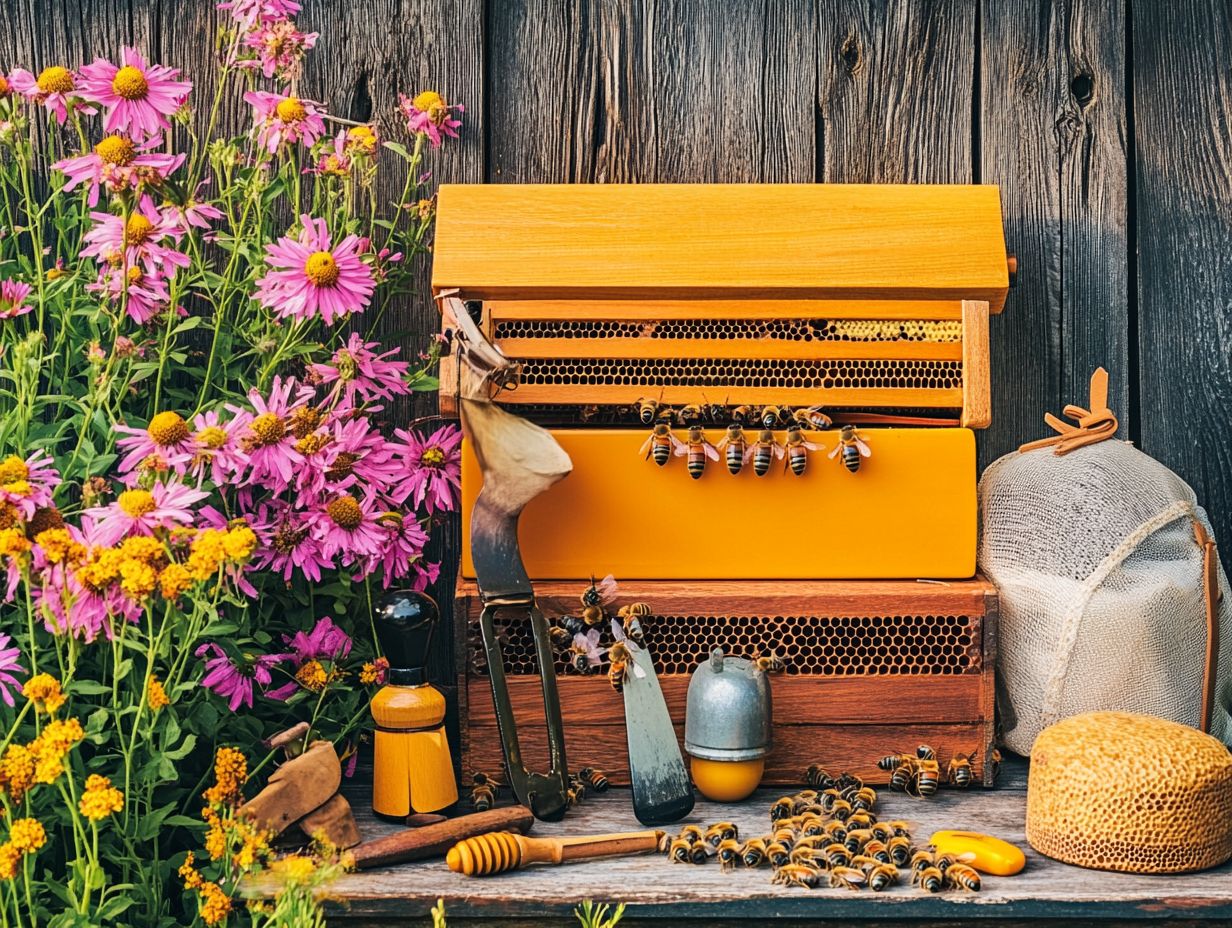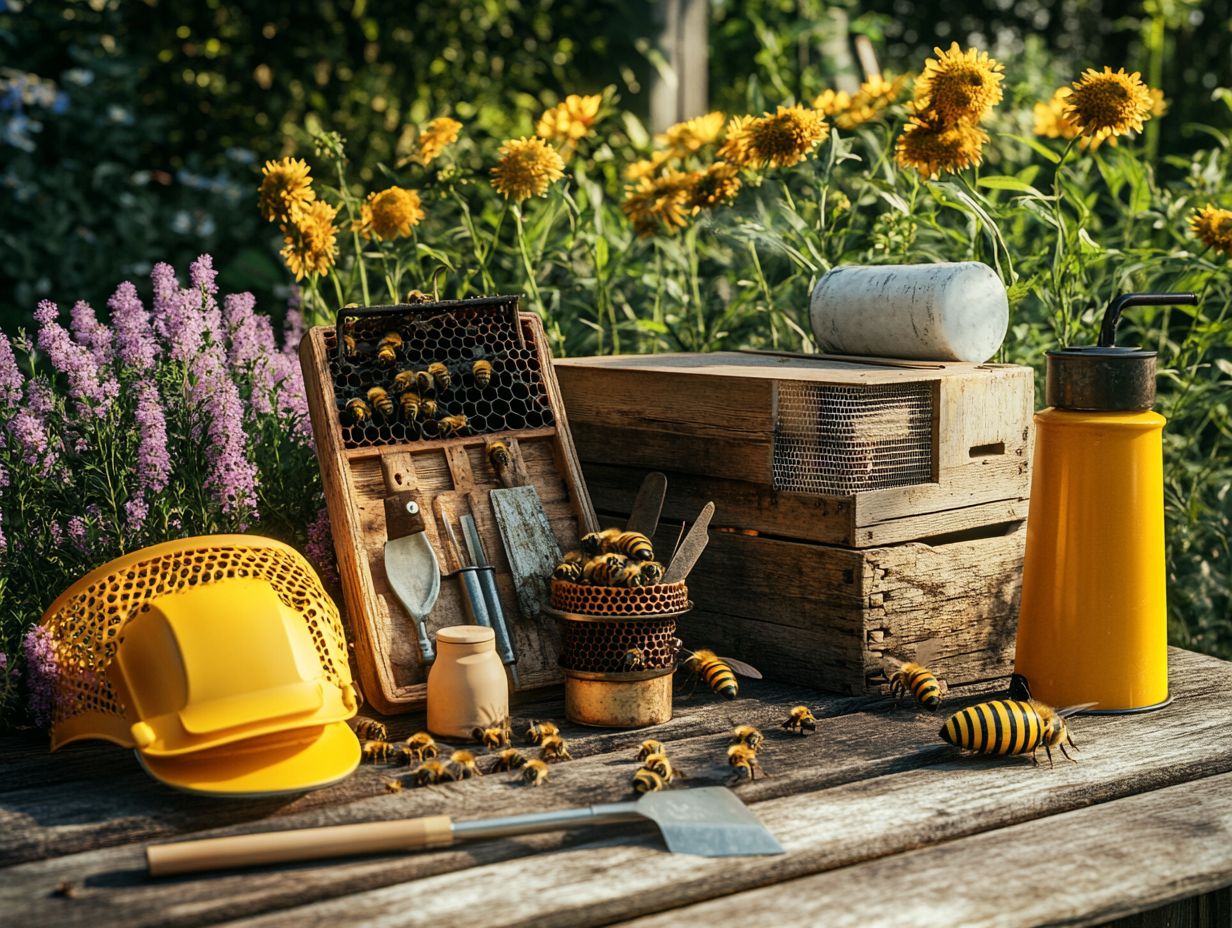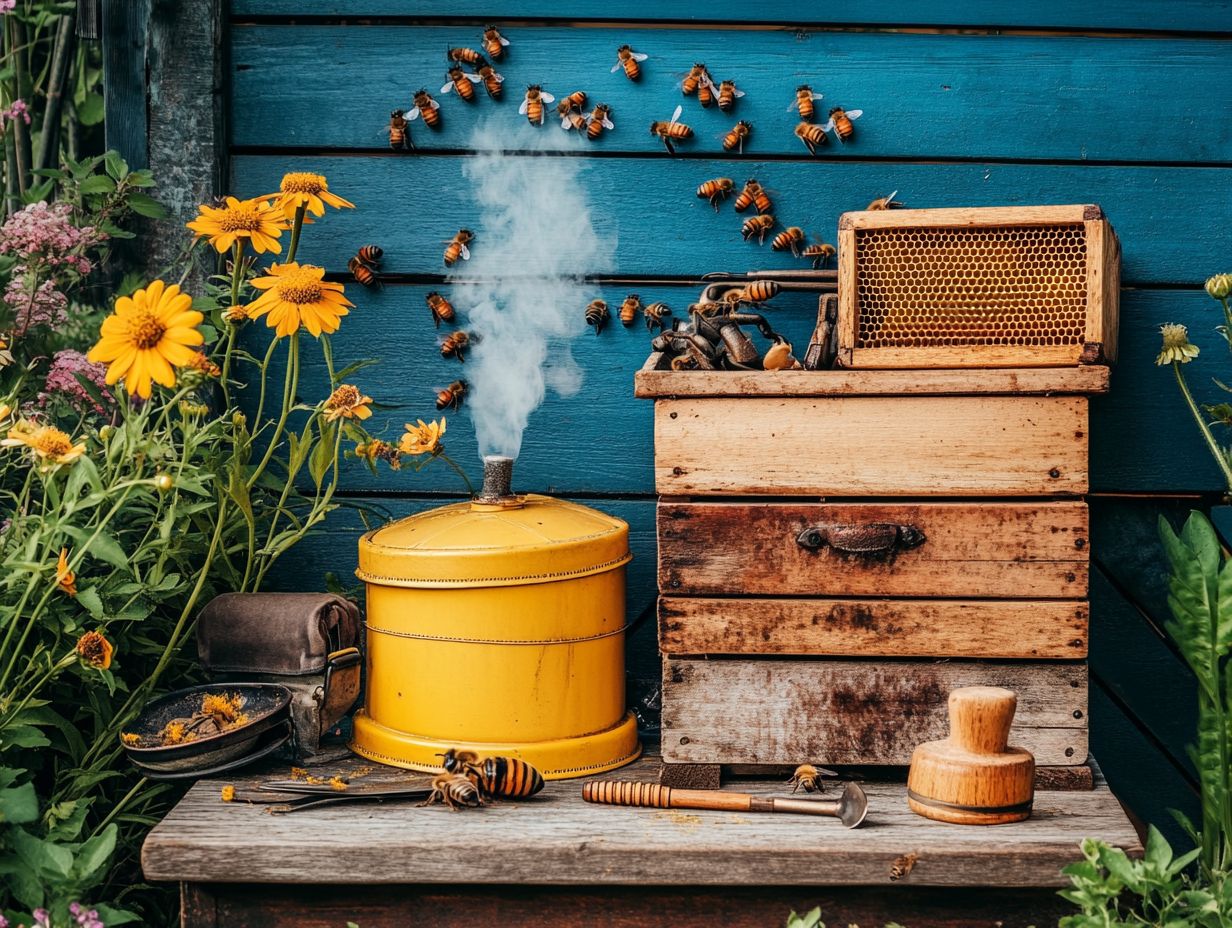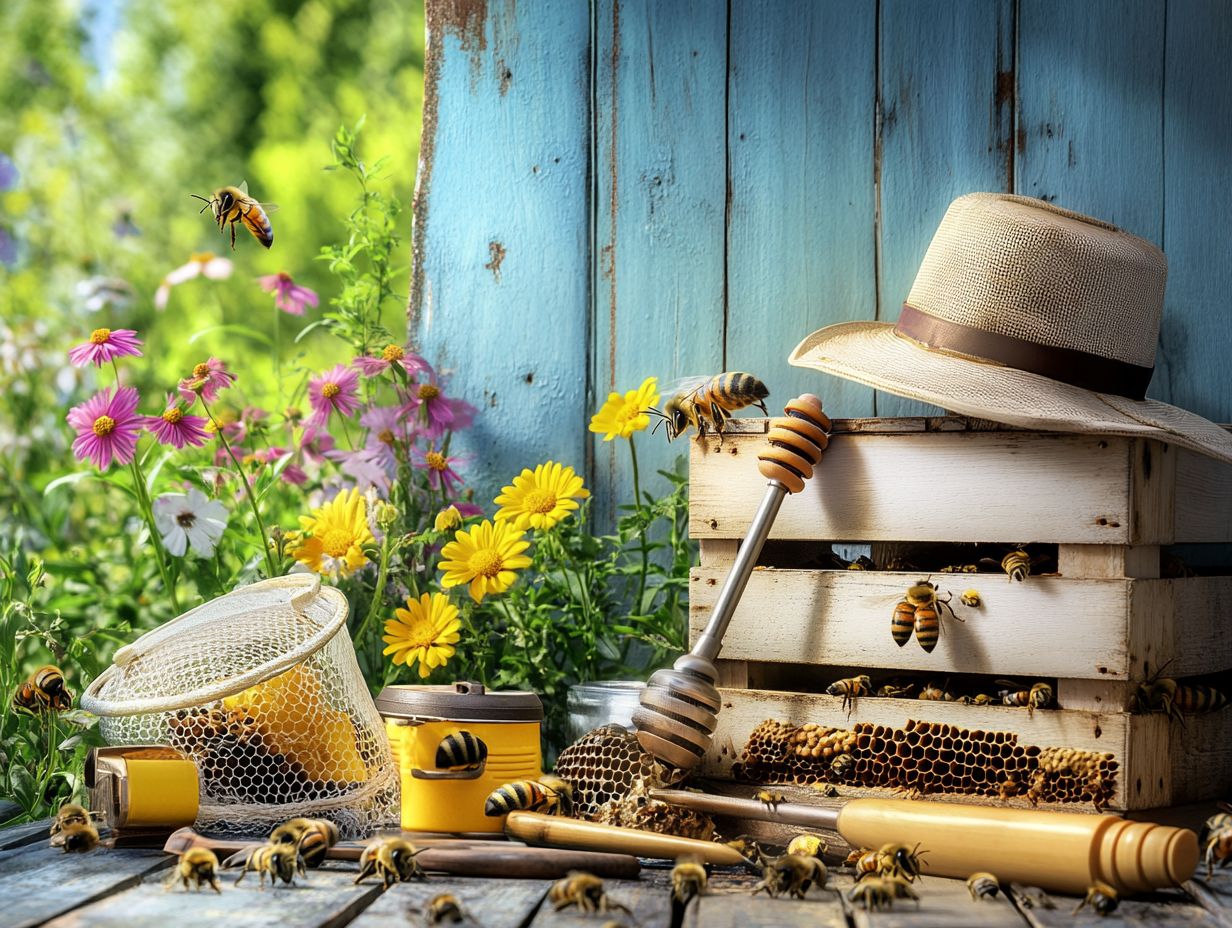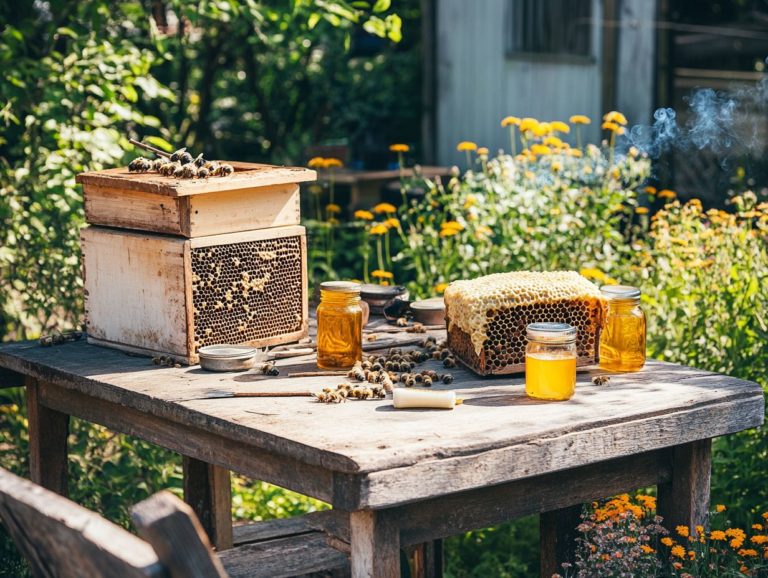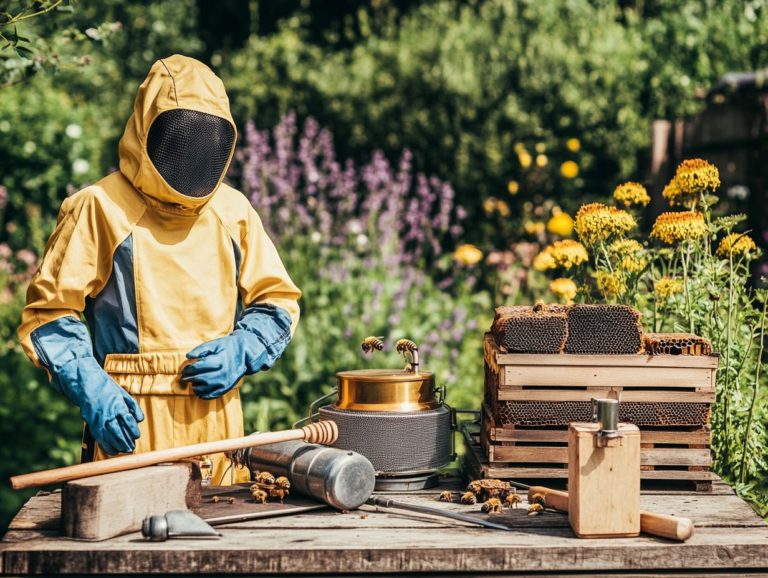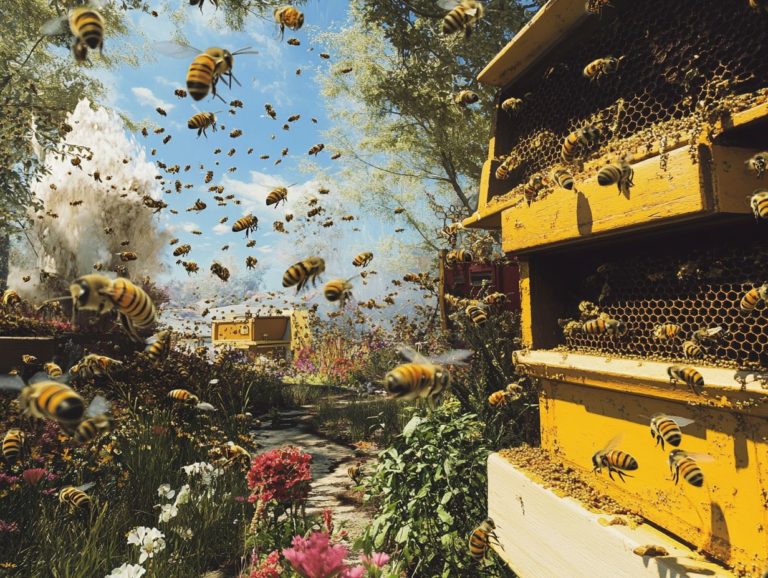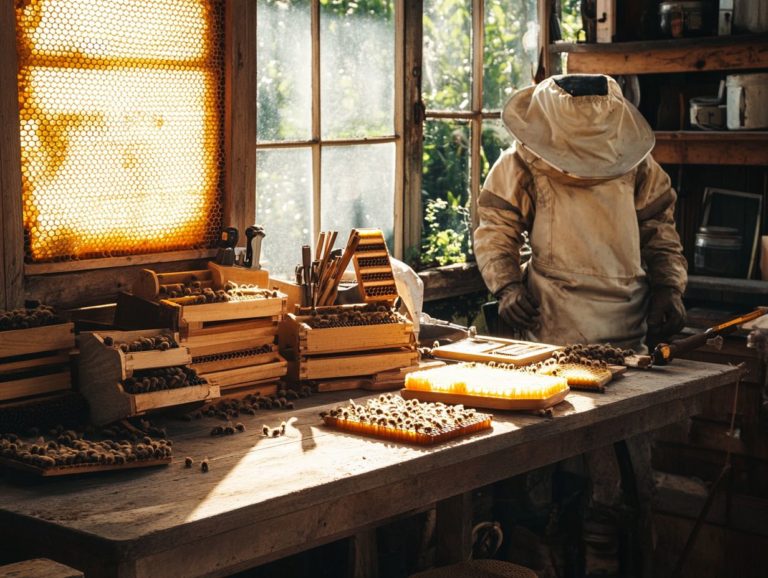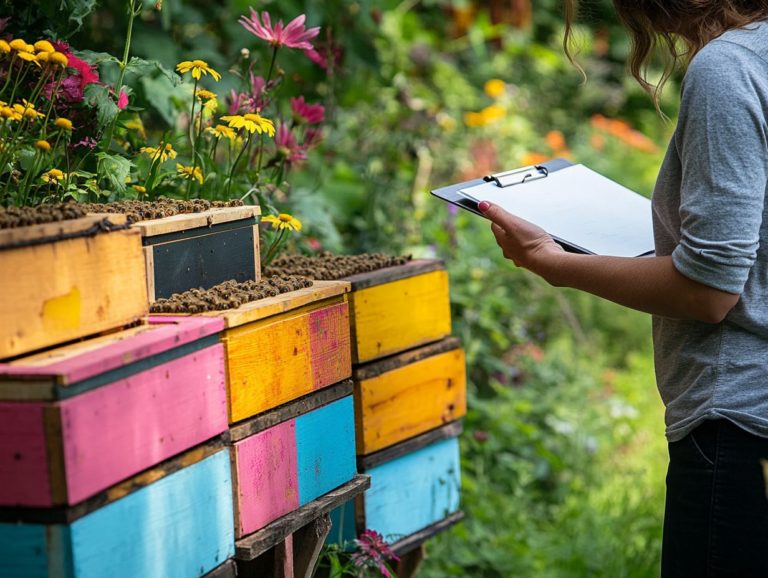Top 5 Beekeeping Mistakes with Equipment
Proper beekeeping equipment is essential for the health of your bees and the quality of your honey. It’s easy to overlook key maintenance practices, whether you’re just starting out or you’ve been tending to hives for years. Those critical mistakes can really set you back.
This article delves into five common pitfalls in managing your beekeeping equipment, covering everything from cleaning and maintenance to ensuring adequate ventilation and protecting your hives from the elements.
Plus, you’ll discover valuable tips on essential tools and best practices that will empower you to thrive on your beekeeping journey.
Contents
- Key Takeaways:
- 1. Not Properly Cleaning and Maintaining Equipment
- 2. Using Poor Quality or Inappropriate Equipment
- 3. Not Providing Adequate Ventilation for Hives
- 4. Not Protecting Equipment from Harsh Weather Conditions
- 5. Not Having Enough Equipment for Growth and Expansion
- How Does Proper Equipment Affect Bee Health and Honey Production?
- What Are the Essential Equipment for Beekeeping?
- How Can One Properly Clean and Maintain Beekeeping Equipment?
- What Are the Different Types of Hives and Which One Is Best for Beginners?
- What Are Some Common Mistakes to Avoid When Setting Up Beekeeping Equipment?
- How Can One Ensure Their Equipment Is Safe from Pests and Predators?
- Frequently Asked Questions
Key Takeaways:
- Regularly clean and maintain beekeeping equipment to prevent the spread of diseases and ensure the health of the bees.
- Invest in high-quality equipment to avoid potential problems and maximize honey production.
- Proper ventilation in hives is crucial for the well-being of bees and the success of the hive.
1. Not Properly Cleaning and Maintaining Equipment
In beekeeping, the importance of carefully cleaning and maintaining your equipment cannot be overstated. Regular inspections and diligent upkeep support your bees’ well-being and guard against diseases while improving overall management.
A clean environment reduces risks linked to chemical treatments that could disrupt the delicate balance within the hive. Establishing a strong routine for equipment maintenance is essential for any serious beekeeper.
Make your maintenance schedule dynamic by including tasks like checking frames for mold or mildew, cleaning feeders and jars to prevent fermentation, and inspecting tools for rust and wear. Prioritize cleaning your honey extractors and sanitizing surfaces to protect your hives. By focusing on these activities, you not only boost the health of your colonies but also enhance inspection efficiency, leading to improved honey production.
Clean equipment enriches the overall ecosystem, creating a healthier environment for your bees to thrive in while diminishing the potential for diseases that could wreak havoc on your hives.
2. Using Poor Quality or Inappropriate Equipment
Using poor quality or inappropriate equipment can significantly undermine hive health and jeopardize honey production. This often leads to suboptimal management practices and increases the risk of pests and diseases.
Investing in high-quality materials is crucial for cultivating a thriving apiary. Well-constructed hives made from durable wood not only offer superior insulation and protection against harsh elements but also enhance the overall stability of your bee colonies. In contrast, flimsy or poorly designed hives can stress the bees, making them more vulnerable to infections and diminishing their honey production capabilities.
Selecting the right tools—like ventilated bee suits and reliable smokers—empowers you to manage your hives with greater efficiency. This thoughtful approach ensures that both bee health and productivity remain top priorities in your beekeeping journey.
3. Not Providing Adequate Ventilation for Hives
Adequate ventilation is essential in beekeeping, as it directly impacts the health of your bees and the quality of the honey they produce. Without proper airflow, hives can easily become overheated or humid, leading to diseases and diminished productivity.
Maintaining optimal conditions within your hive is crucial for nurturing a thriving colony. You can achieve effective ventilation through various methods, such as:
- Installing screened bottom boards
- Ensuring sufficient spacing between hive boxes to promote airflow
- Positioning your hives in shaded areas or utilizing ventilation openings during the summer months
These measures will help regulate temperature and humidity levels. Keep in mind that environmental factors, like local climate and seasonal changes, significantly influence hive health. Therefore, continuous monitoring and adjustments are vital to protect the well-being of your bees and ensure the production of high-quality honey.
4. Not Protecting Equipment from Harsh Weather Conditions
Protecting your beekeeping equipment from harsh weather conditions is vital for maintaining the integrity of your hives and ensuring the overall health of your bees. Exposure to extreme temperatures, moisture, and pests can lead to significant damage and operational setbacks that you definitely want to avoid.
To extend the life of your equipment, consider investing in weather-resistant materials like treated wood or galvanized metal. These choices are designed to withstand moisture and resist decay. Proper storage solutions, such as ventilated sheds or dedicated garages, are essential for shielding your beekeeping tools from changing temperatures and humidity levels.
Neglecting these protective measures can lead to serious consequences. You may experience deterioration of your hives, reduced honey production, and even the loss of bee colonies. Ultimately, this could impact local ecosystems and agricultural productivity. Taking these steps is crucial for your success!
5. Not Having Enough Equipment for Growth and Expansion
Not having enough equipment to support your growth and expansion in beekeeping can seriously hinder hive productivity and limit your honey production potential. As your bee populations increase, a lack of adequate resources can lead to overcrowding and stress within the hives.
To sidestep these challenges, it’s essential to anticipate your equipment needs and plan accordingly. This proactive approach involves assessing your current hive capacity and estimating future demands based on population trends and nectar availability.
Investing in additional equipment, such as supers, frames, and extraction tools, not only streamlines your operations but also boosts the overall health of your colonies. Regularly reviewing hive performance data provides valuable insights into when to expand. Ensuring every bee has ample space to thrive will ultimately optimize your honey yield and enhance hive sustainability.
How Does Proper Equipment Affect Bee Health and Honey Production?
Proper equipment is essential in beekeeping, significantly impacting both bee health and honey production. The right tools not only make hive management more efficient but also create an optimal environment for your bees to thrive. This enhances their productivity and overall well-being, especially when managing pests and diseases.
Choosing quality materials is key, as they provide insulation and protect against harsh weather conditions. Regular maintenance practices, like inspecting for wear and tear, ensure that your hive remains a secure haven for the bees.
Investing in equipment designed to combat common pests and diseases can greatly alleviate stress on your colonies. These proactive measures not only support healthier bee populations but also lead to higher honey yields. This illustrates how thoughtful beekeeping practices can truly bear fruit.
What Are the Essential Equipment for Beekeeping?
Essential equipment for your beekeeping journey includes items that are crucial for maintaining hive health and ensuring efficient honey production. Think hives, protective gear, and the right tools for inspections and management.
These are not just mere accessories; they are vital components that create a safe environment for your bees while allowing you to effectively monitor your colonies. For example, hive tools enable you to conduct thorough inspections, providing insights into the brood pattern and overall health of your bees. A smoker is critical, helping to calm the bees during handling and reducing stress within the colony.
Together, these pieces of equipment play a significant role in the well-being of your bees and directly impact the quantity and quality of honey you produce. They are fundamental to running a successful beekeeping operation, ensuring that all aspects of bee health, including nutrition and pest management, are addressed.
How Can One Properly Clean and Maintain Beekeeping Equipment?
Properly cleaning and maintaining your beekeeping equipment is essential for ensuring the health of your hive and the quality of the honey you produce. Regular upkeep not only prevents the buildup of harmful substances but also significantly reduces the risk of disease among your bees.
You should establish a comprehensive schedule that incorporates routine inspections, thorough cleanings, and any necessary repairs. Monthly checks can help you spot wear and tear on equipment, such as hive boxes and frames. Seasonal deep cleaning of tools like smokers and extractors helps prevent harmful contaminants. This practice is crucial for maintaining the health and productivity of your bees.
Pay special attention to wooden components; they benefit from a good scrubbing using soap and hot water, followed by disinfection with food-safe agents. By committing to this regular maintenance, you can enhance the overall productivity of your hives and ensure that your colonies remain strong and healthy, ready to thrive season after season.
What Are the Different Types of Hives and Which One Is Best for Beginners?
In beekeeping, understanding the various types of hives is crucial, especially if you’re just starting out. The right hive can greatly impact the health of your bees, how efficiently you manage them, and the amount of honey you produce.
Familiarize yourself with popular hive options like Langstroth, Top-Bar, and Warre for valuable insights. The Langstroth hive, with its rectangular design, is a favorite among many beekeepers due to its frames that fit uniformly within the hive and ease of honey extraction, though it may require more equipment and upkeep.
On the other hand, the Top-Bar hive encourages a more natural flow, making it a great choice for those seeking simplicity, even if it doesn’t allow for a quick honey harvest. The Warre hive, with its vertical structure that mimics natural bee habitats, promotes a sustainable approach, but it might complicate inspections.
As a beginner, it’s essential to consider your personal goals—whether you’re looking to maximize honey yield or opt for a simpler way of keeping bees—to select the hive that truly aligns with your aspirations.
What Are Some Common Mistakes to Avoid When Setting Up Beekeeping Equipment?
When setting up your beekeeping equipment, avoiding common mistakes is crucial for ensuring the health of your hives and effective management. These pitfalls can lead to increased risks of pests, disease, and subpar honey production.
As a new beekeeper, you might overlook the importance of adequate spacing and ventilation. Efficient airflow around the hive is essential for maintaining optimal temperature and humidity levels, both of which are vital for your colony’s health.
Investing in high-quality materials is essential for success; taking shortcuts can result in hastily assembled frames that warp or break, compromising the structural integrity of your hive.
It’s equally important to designate the location of your equipment clearly; improper placement can create accessibility issues during inspections.
To avoid these frequent errors, take the time to visualize your setup, invest in durable materials, and ensure that each component is easily accessible. This approach will facilitate regular hive management and contribute to your beekeeping success!
How Can One Ensure Their Equipment Is Safe from Pests and Predators?
Ensuring your beekeeping equipment is safeguarded against pests and predators is essential for maintaining hive health and maximizing honey yield. By taking proactive measures, you can prevent big losses and create a stable environment for your bees.
Implementing various strategies establishes a protective barrier around your hives. Physical barriers, like nets or screens, effectively deter larger predators. Well-designed hive stands help keep pesky mice at bay.
Incorporating monitoring systems with traps allows you to identify potential threats before they escalate. This enables timely intervention. Appropriate chemical treatments, when used carefully, can act as a last defense against invasive species, ensuring your bees remain undisturbed.
These strategies also make your hives stronger and promote a sustainable approach to hive management.
Frequently Asked Questions
What are the top 5 beekeeping mistakes with equipment?
The top 5 beekeeping mistakes with equipment are using the wrong size hive, not cleaning equipment properly, not having enough protective gear, not labeling equipment, and not storing equipment correctly.
How do I know if I am using the wrong size hive?
If your bees are not filling the entire hive with comb (the wax structure bees build), or if the hive feels too crowded, you may be using the wrong size hive. Choosing the right hive size is crucial for thriving bees!
How often should I clean my beekeeping equipment?
Beekeeping equipment should be cleaned after each use to prevent the spread of diseases and parasites. A thorough cleaning is also recommended at the end of each season.
What are the consequences of not wearing enough protective gear while beekeeping?
Not wearing sufficient protective gear while beekeeping can result in bee stings, which can be painful and potentially dangerous for those with allergies. It is vital to wear protective gear, such as a bee suit and gloves, to shield yourself from stings.
Why is it important to label beekeeping equipment?
Labeling beekeeping equipment is important for organization and to prevent the spread of diseases. By labeling equipment, you can track which items have been used in which hive, avoiding contaminated gear on healthy hives.
How should I store beekeeping equipment?
Beekeeping equipment should be stored in a dry, cool place to prevent damage from moisture and pests. It’s also crucial to keep equipment away from other chemicals or substances that could harm the bees.

